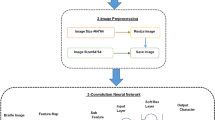Abstract
Braille documents are part of the collaboration with blind people. To overcome the problem of learning Braille as a sighted person, a technical solution for reading Braille would be beneficial. Thus, a mobile and easy-to-use system is needed for every day situations. Since it should be a mobile system, the environment cannot be controlled, which requires modern computer vision algorithms. Therefore, we present a mobile Optical Braille Recognition system using state-of-the-art deep learning implemented as an app and server application.
Access this chapter
Tax calculation will be finalised at checkout
Purchases are for personal use only
Similar content being viewed by others
Notes
- 1.
Emfuse, EmBraille from Viewplus and Everest from Index Braille.
References
Brooke, J., et al.: SUS: a quick and dirty usability scale. In: Usability Evaluation in Industry, pp. 189–194 (1996)
Deng, Y., Kanervisto, A., Ling, J., Rush, A.M.: Image-to-markup generation with coarse-to-fine attention. In: Proceedings of the 34th International Conference on Machine Learning, vol. 70, pp. 980–989. JMLR. org (2017)
Google: Tensorflow (2019). https://www.tensorflow.org/. Accessed 5 Jan 2020
Google: Android sdk (2020). https://developer.android.com/studio/releases. Accessed 14 Apr 2020
Hentzschel, T., Blenkhorn, P.: An optical reading system for embossed Braille characters using a twin shadows approach. J. Microcomput. Appl. 18(4), 341–354 (1995)
Hinderks, A., Schrepp, M., Thomaschewski, J.: User experience questionaire (2020). https://www.ueq-online.org/. Accessed 18 Mar 2020
Isayed, S., Tahboub, R.: A review of optical braille recognition. In: 2015 2nd World Symposium on Web Applications and Networking (WSWAN), pp. 1–6. IEEE (2015)
Levenshtein, V.I.: Binary codes capable of correcting deletions, insertions, and reversals. Soviet physics doklady 10, 707–710 (1966)
Liblouis* (2019). http://liblouis.org/. Accessed 4 Dec 2019
Lin, T.-Y.: Microsoft COCO: common objects in context. In: Fleet, D., Pajdla, T., Schiele, B., Tuytelaars, T. (eds.) ECCV 2014. LNCS, vol. 8693, pp. 740–755. Springer, Cham (2014). https://doi.org/10.1007/978-3-319-10602-1_48
Quasthoff, U., Richter, M.: Projekt Der Deutsche Wortschatz (1998)
Ren, S., He, K., Girshick, R.B., Sun, J.: Faster R-CNN: towards real-time object detection with region proposal networks. CoRR abs/1506.01497 (2015). http://arxiv.org/abs/1506.01497
Schwarz, T., Dolp, R., Stiefelhagen, R.: Optical braille recognition. In: Miesenberger, K., Kouroupetroglou, G. (eds.) ICCHP 2018. LNCS, vol. 10896, pp. 122–130. Springer, Cham (2018). https://doi.org/10.1007/978-3-319-94277-3_22
Shi, B., Bai, X., Yao, C.: An end-to-end trainable neural network for image-based sequence recognition and its application to scene text recognition. IEEE Trans. Pattern Anal. Mach. Intell. 39(11), 2298–2304 (2016)
Author information
Authors and Affiliations
Corresponding author
Editor information
Editors and Affiliations
Rights and permissions
Copyright information
© 2020 Springer Nature Switzerland AG
About this paper
Cite this paper
Baumgärtner, C., Schwarz, T., Stiefelhagen, R. (2020). Image-Based Recognition of Braille Using Neural Networks on Mobile Devices. In: Miesenberger, K., Manduchi, R., Covarrubias Rodriguez, M., Peňáz, P. (eds) Computers Helping People with Special Needs. ICCHP 2020. Lecture Notes in Computer Science(), vol 12376. Springer, Cham. https://doi.org/10.1007/978-3-030-58796-3_41
Download citation
DOI: https://doi.org/10.1007/978-3-030-58796-3_41
Published:
Publisher Name: Springer, Cham
Print ISBN: 978-3-030-58795-6
Online ISBN: 978-3-030-58796-3
eBook Packages: Computer ScienceComputer Science (R0)





